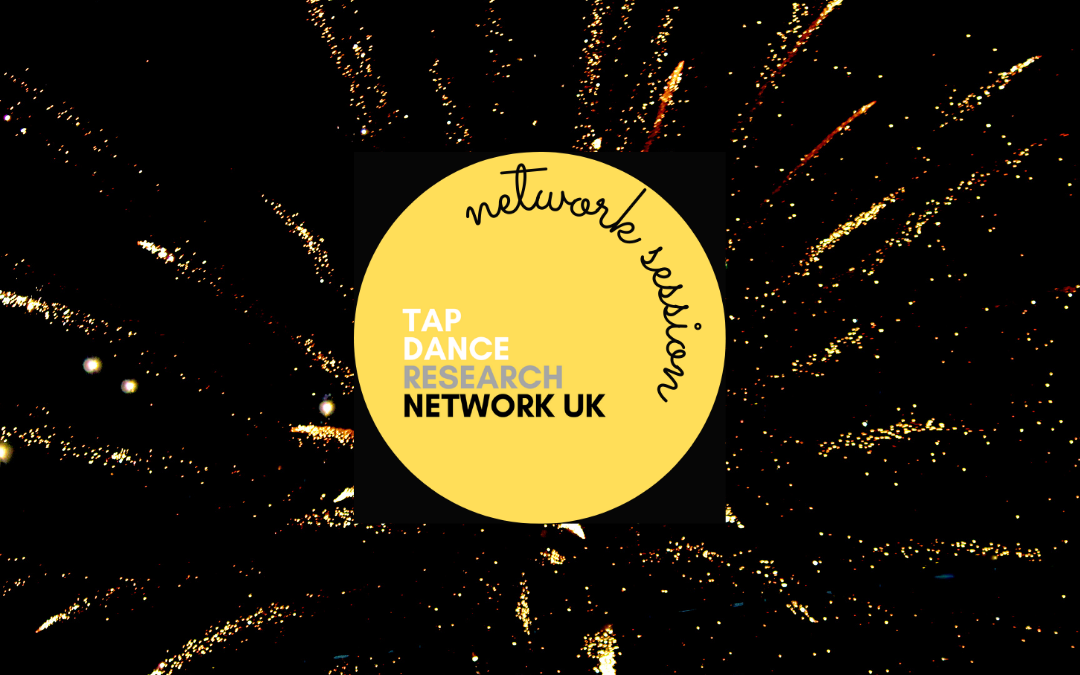Our first ever TDRN UK Network Session was an opportunity for us to explore what members of the group were interested in discussing and sharing information and experiences about. Initial topics included:
- How to teach and educate learners about the histories and culture of tap dance
- Different ways of making tap dance performance work
- The life stories of tap dancers
- The history of tap dance in the UK and it’s relationship to tap dance communities in North America
- The aesthetic angle in tap dance teaching
- The ways that tap dance influences other art forms
Salon Bam led by Jess Murray: How do we reflect the culture and histories of tap dance in our research?
Jess opened up a discussion by introducing her Ph.D practice research project which looks at how ideas and themes are communicated in making dance and music collaborative improvisation-as-performance work. Jess shared questions that have arisen for her as a result of framing her own tap dance practice in a research context. This also highlights some of the tensions in the relationship between tap dance and academic institutions which need to be addressed in order to do ethical and effective research.
Jess spoke about the need to approach her research in a way that fits her own practice (improvisation, collaborative, community oriented) and is appropriate for tap dance as an art form/ cultural perspective which can often be at odds with mainstream academia. Doing ‘practice research’ which places physical experience at the centre of the learning is helpful, but other issues remain…
For example –
- As an Oral history, there are not extensive written records so other methods are needed to gather information
- Tap Dance aesthetics differ from dance and music forms that are more prevalent in academia. There is a need to develop alternative approaches that come from the perspective of tap dance rather than ‘borrowing’ from something else that ‘doesn’t fit’
- Discussion around improvisation by jazz music and Improvisation Studies scholars is useful, but at present there is very little that connects with tap dance as both dance and music.
The conversation then opened up to the group in response to the questions raised. Sally Crawford-Shepherd shared her experiences of doing an Ethnographic study of UK Tap Jams. Discussed Ethnography as a tool to create a portrait of people. Participatory observation. Story of the people.
Areas of future interest raised by the group included:
- Wooden tap shoes
- Discussion about tap dance a folk dance and other percussive folk dance forms that we are interested in such as British clog dance and Irish Sean-nós dance which is improvisatory. https://en.wikipedia.org/wiki/Sean-n%C3%B3s_dance
- We would like to know more about the early history or ‘pre-history’ of ‘tap’ dance and the experiences of those that were dancing at the time. Might there be experimental and innovative approaches to history that can reveal more in cases where certain oral history may have been lost? In addition to the oral tradition, what other ways of doing historical research through physical experience are there…?
- Considering tap dance from the perspectives of Folk tradition, Vernacular and popular culture, visual music. Thinking about ways of working with oral and embodied histories, and how this connects with written histories.
Resources mentioned in the session:
- BERLINER, Paul F. (1994) Thinking in Jazz: The Infinite Art of Improvisation. Chicago: University of Chicago Press.
- WRAY, S “Just after the pulse, rhythm takes all: the inside habitat of improvisation” in ADAIR, C and BURT, R (2017) British Dance: Black Routes. Routledge.
- WELSH-ASANTE, Kariamu ‘The “Gospel” of Memory Inscribed Bodies in the African Diaspora’ in WELSH-ASANTE, Kariamu et al (2019) Hot Feet and Social Change : African Dance and Diaspora Communities. University of Illinois Press.
- CARLOZZO, Abby ‘Embodying Rhythm Improvisation as Agency in African Dance’ in WELSH-ASANTE, Kariamu et al (2019) Hot Feet and Social Change : African Dance and Diaspora Communities. University of Illinois Press.
- HEBLE, A, CAINES, R (2014) The Improvisation Studies Reader: Spontaneous Acts. Routledge
- WILLIS, Cheryl. ‘Tap Dance: Manifestation of the African Aesthetic’ in WELSH-ASANTE, Kariamu. (1998) African Dance: An Artistic, Historical and Philosophical Inquiry Africa World Press, New Jersey
- OLIVER, W & GUARINO, L (2014) Jazz Dance: A History of the Roots and Branches. Gainesville, Florida: University Press of Florida
Travis Knight’s podcast about re-naming tap dance suggested. Tap. Love. Tour. Hosted by Travis Knights. Originally first recorded on April 3, 2015. Travis Knights’ Website Soundcloud Stitcher Apple.com
Jacobs Pillow Interactive Resources https://www.jacobspillow.org/school/

